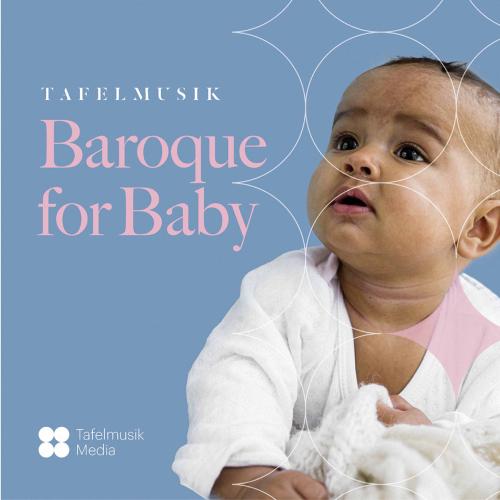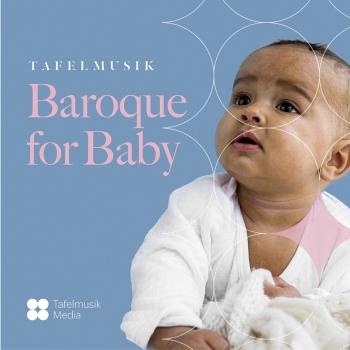
Baroque for Baby Tafelmusik Baroque Orchestra
Album Info
Album Veröffentlichung:
2020
HRA-Veröffentlichung:
20.10.2020
Das Album enthält Albumcover Booklet (PDF)
- Georg Philipp Telemann (1681 - 1767):
- 1 Ouverture-Suite in G Major, TWV 55:G10 "Burlesque de Quixotte": III. Son attaque des moulins à vent 01:50
- Jean-Baptiste Lully (1632 - 1687): Phaëton, LWV 61 (Excerpts):
- 2 Phaëton, LWV 61 (Excerpts): Ritournelle "Le printemps" 01:06
- 3 Phaëton, LWV 61 (Excerpts): Air pour les Égyptiens "L'été" 01:27
- 4 Phaëton, LWV 61 (Excerpts): Air pour Triton et ses suivants "L'automne" 01:32
- 5 Phaëton, LWV 61 (Excerpts): Air pour les peuples qui portent des présents à Isis "L'hiver" 01:32
- 6 Phaëton, LWV 61 (Excerpts): Entrée des furies 01:10
- 7 Phaëton, LWV 61 (Excerpts): Chaconne 03:47
- Claudio Monteverdi (1567 - 1643):
- 8 L'Orfeo, SV 318 (Excerpts): Ritornello 01:44
- 9 Zefiro torna e di soavi accenti, SV 251 (Arr. for Chamber Ensemble) 02:30
- Tarquinio Merula (1595 - 1665):
- 10 Ciaccona, Op. 12 No. 20 02:35
- Antonio Vivaldi (1678 - 1741):
- 11 Bassoon Concerto in D Minor, RV 481: I. Allegro 04:03
- George Frideric Handel (1685 - 1759): Alcina, HWV 34 (Excerpts):
- 12 Alcina, HWV 34 (Excerpts): Entrée des songes agréables 02:42
- 13 Alcina, HWV 34 (Excerpts): Gavotte 01:05
- 14 Alcina, HWV 34 (Excerpts): Tamburino 01:50
- Jan Pieterszoon Sweelinck (1562 - 1621):
- 15 Engelsche fortuyn, SwWV 320 (Arr. for Harpsichord) 02:38
- Antonio Vivaldi: Violin Concerto in E Major, RV 271 "L'amoroso":
- 16 Violin Concerto in E Major, RV 271 "L'amoroso": I. Allegro 03:45
- 17 Violin Concerto in E Major, RV 271 "L'amoroso": II. Cantabile 02:46
- 18 Violin Concerto in E Major, RV 271 "L'amoroso": III. Allegro 02:57
- Antonio Vivaldi:
- 19 Lute Concerto in D Major, RV 93: III. Allegro 02:17
- Marin Marais (1656 - 1728): Alcyone (Excerpts):
- 20 Alcyone (Excerpts): Marche des matelots 00:34
- 21 Alcyone (Excerpts): Act III Ritournelle 00:52
- 22 Alcyone (Excerpts): Tambourins I & II 01:53
- Georg Philipp Telemann: Concerto for 4 Violins in G Major, TWV 40:201 (Excerpts):
- 23 Concerto for 4 Violins in G Major, TWV 40:201 (Excerpts): I. Largo e staccato 02:03
- 24 Concerto for 4 Violins in G Major, TWV 40:201 (Excerpts): IV. Vivace 01:41
- Marin Marais:
- 25 Alcyone (Excerpts): Act V Ritournelle 02:16
- Jean-Philippe Rameau (1683 - 1764):
- 26 Hippolyte et Aricie: Entrée de Jupiter 00:52
- George Frideric Handel:
- 27 Trio Sonata in G Minor, Op. 2 No. 5, HWV 390: II. Allegro 02:52
- Antonio Vivaldi: Concerto for 2 Violins in A Major, Op. 3 No. 5, RV 519 (Excerpts):
- 28 Concerto for 2 Violins in A Major, Op. 3 No. 5, RV 519 (Excerpts): I. Allegro 02:23
- 29 Concerto for 2 Violins in A Major, Op. 3 No. 5, RV 519 (Excerpts): II. Largo 01:42
- Claudio Monteverdi:
- 30 L'Orfeo, SV 318 (Excerpts): Moresca 02:14
- Henry Purcell (1659 - 1695):
- 31 Abdelazer, Z. 570: II. Rondeau 01:30
- 32 3 Parts upon a Ground, Z. 731 04:29
- 33 The Indian Queen, Z. 630: Act III Tune (Rondeau) 01:37
- Antonio Vivaldi: Ottone in villa, RV 729 (Excerpts):
- 34 Ottone in villa, RV 729 (Excerpts): Sinfonia. Allegro 02:55
- 35 Ottone in villa, RV 729 (Excerpts): Sinfonia. Larghetto 01:39
- Anonymous:
- 36 Playlist Curator Commentary 08:13
Info zu Baroque for Baby
Following its first digital-only release in March 2020, Tafelmusik returns with Baroque for Baby, a kid-friendly playlist curated by violinist and mother of two, Cristina Zacharias. Tafelmusik’s core baroque repertoire has particular appeal for younger listeners — catchy dance music with great rhythms, singable melodies, plenty of repetition, and lots of opportunity to showcase the textures and sounds of various wind, string, and plucked instruments.
Selections from renowned Tafelmusik recordings include music by Telemann, Purcell, Lully, Vivaldi, Handel, Monteverdi, Rameau, Merula, Sweelink, and Marais. Zacharias’s choices balance enlivening, energetic music that encourages children to move and dance with calming, quieter pieces for bedtime.
“There is nothing more magical than watching a baby or young child respond to music — the immediate natural and instinctive response to melody and rhythm is a reminder of just how fundamental music is in our lives. There are countless studies and reports that show the impact of music on the developing mind — improvements are evident in self-regulation, spatial awareness, memory, language development, self-expression, motor skills, just to name a few. Music and learning are interwoven in our brains in a powerful way. As a musician and a parent, the importance of music for babies is no surprise to me. In selecting the program for this playlist, my guiding principle was not particularly scientific: music is fun! (Cristina Zacharias)
Tafelmusik Baroque Orchestra
Tafelmusik Baroque Orchestra
Every now and then a group of musicians comes along and changes the way we think about music. Tafelmusik has done just that. Music for feasting. It is a name that, for almost four decades, has been synonymous worldwide with dynamic, engaging, and soulful performances.
Whether on tour or at home in Trinity-St-Paul’s Centre, an historic church in the Annex neighbourhood of Toronto, at its heart Tafelmusik Baroque Orchestra and Chamber Choir is a family of collaborative musicians. Steeped in the historical traditions of the baroque and classical eras, together they form one of the world’s leading period ensembles.
Tafelmusik is Canada’s most toured orchestra, having performed in over 350 cities in 32 countries, and its international reputation is without question. In January 2017 the orchestra announced the appointment of violinist Elisa Citterio, only the second Music Director in its history. With her stunning virtuoso performances and innovative approach to period performance, the future is indeed bright in Ms. Citterio’s hands.
Under the direction of Ivars Taurins, the Chamber Choir has become one of the most fêted in North America. The vitality of Tafelmusik’s vision clearly resonates with its loyal audiences at home in Toronto, where the ensemble performs some 80 concerts every year, a focal point of Toronto’s lively early music scene.
Rewind to 1979: visionary founders oboist Kenneth Solway and bassoonist Susan Graves began bringing together like-minded musicians to experiment with historically informed performance practice. Their exploration of baroque and classical repertoire quickly started winning audiences, and in 1981 they expanded to form the choir.
The year 1981 also marked the arrival of Music Director Jeanne Lamon. Directing from the violin and embracing an inclusive approach, Lamon’s infectious musicality set Tafelmusik on an upwards trajectory. What was the key to this success? Tafelmusik’s strong identity may be attributed to its core of seventeen permanent instrumentalists, a rarity in period orchestras. Under Jeanne Lamon’s leadership the orchestra and choir developed its trademark sound: transparent, yet rich and vital. The ensemble came to be recognized for its innovative and creative programming, blending familiar masterworks with rare gems. But above all, the reason audiences kept returning was to experience Tafelmusik’s unique brand of engagement. Attend a Tafelmusik concert and you feel individually involved: you have been given an invitation to become a member of the extended Tafelmusik family.
Today, Tafelmusik’s catalogue of award-winning recordings continues to demand the attention of the world stage. Over 85 recordings on the Sony, CBC Records, Analekta, and since 2012, Tafelmusik Media labels, have garnered nine JUNOs and numerous other recording prizes. Today you regularly see Tafelmusik as Record of the Month in BBC Music Magazine, Editor’s Choice in Gramophone Magazine, or Record of the Year in Absolute Sound Magazine.
Masters in transporting audiences to the worlds in which their instruments inhabited, the musicians of the Tafelmusik Baroque Orchestra and Chamber Choir are always seeking out new ways to remain vibrant and relevant to modern audiences. Whether in cross-cultural collaborations, on stage with Opera Atelier, with the annual tradition of Sing-Along Messiah with Herr Handel at the podium, or at a bar for the new Haus Musik series, theatricality has become a Tafelmusik trademark. Multimedia programs such as The Galileo Project: Music of the Spheres (which resulted in the naming of asteroid “197856 Tafelmusik” in 2012) conceived by bassist Alison Mackay, fuse narration, projected images, and music, and have received huge acclaim worldwide.
Tafelmusik is committed to sharing their knowledge and experience through their various artist training initiatives, chief among them the Tafelmusik Baroque Summer and Winter Institutes. Musicians come to Toronto from around the globe to attend these intensive and varied programs. In addition to delving into the study of historical performance, these young musicians also experience the special alchemy that sets Tafelmusik apart.
Online, on tour, or on Bloor Street, Tafelmusik continues to reinvent itself while remaining true to its roots. In the newly refurbished Jeanne Lamon Hall at Trinity St Paul’s Centre, crystal-clear performances of Bach, Handel, and Mozart are still as fresh as ever, and across the city at Koerner Hall, Toronto Centre for the Arts, or underground Haus Musik venues, Tafelmusik reaches out to a multiplicity of audiences. Four decades young, Tafelmusik continues to deliver a feast for the senses.
Booklet für Baroque for Baby









